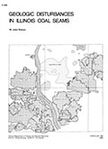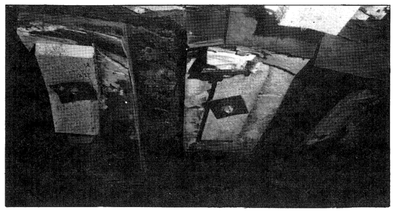Circular 530 Joints
| Geologic Disturbances in Illinois Coal Seams | ||||||||||
|---|---|---|---|---|---|---|---|---|---|---|
| Channels | Split Coal | Rolls | Limestone Bosses | Clay Dikes | White Top | Igneous Dikes | Joints | Coal Balls | Miscellaneous Disturbances | Acknowledgments |
Joints
Joints are planar fractures along which no measurable slippage has occurred. Fractures with slippage are known as faults and are discussed in Nelson (1981). Joints occur in most rocks, including coal, limestone, sandstone, and many varieties of shale. Joints in coal and in the strata above coal seams significantly influence mining operations.
Joints in Coal (Cleat)
Bituminous coal contains abundant joints, commonly called cleat (fig. 16). Cleat lies perpendicular to the bedding-vertical if the seam is not pitching. The number, spacing, and orientation of cleat affect the physical properties of coal as well as how it is mined and used.
Most coal seams in Illinois contain two intersecting sets of cleat roughly at right angles to each other (fig. 16). The more prominent set of joints, extending fairly continuously through the coal, is called the face cleat. Connecting but not penetrating the face cleat is a less prominent set of fractures known as the butt cleat. Together, the face and butt cleat produce the characteristic blocky fracture of bituminous coal. Most coal contains more than two sets of cleat, but the extra sets may not be as obvious.
The terms face and butt cleat come from the days of hand loading. Coal was easier to cut when mined with the prominent cleat parallel and the secondary cleat at right angles to the face, The practice lasted while the mines were mechanized because coal breaks out more uniformly when shot, if the face cleat is parallel with the working face. Now that continuous miners do most underground mining, little or no attention is paid to the direction of the cleat.
The spacing of face and butt cleat can vary from a fraction of an inch to as much as 2 feet. The Lower and Upper Block Coals of Indiana were named for the unusually wide spacing of their cleat, allowing the coal to be extracted in large chunks. Block coal formerly was in demand as a fuel for hand-fired furnaces, stoves, and fireplaces (Wier,1973). In contrast, friable coal contains ten or more joints to the inch, which creates a large amount of dust and slack when mined. This is less of a disadvantage than it used to be, now that most coal is pulverized for fueling power plants. The fine coal is still an environmental hazard during mining, handling, and shipping. In Illinois, most coal falls between these two extremes, with fractures spaced roughly 1/2 to 4 inches apart.
Mining problems.
Few difficulties in mining, handling, or using Illinois coal have been related to the spacing of cleat, so the subject has received little attention from either industry or scientists.
Ash and sulfur are found in the mineral facings that fill the cleat. The most common minerals are calcite, pyrite, various clays, and sphalerite (zinc sulfide) (Cobb et al., 1980). Generally, the mineral facings are paper thin. They may occur on face cleat, butt cleat, or both. These impurities are relatively easy to wash out of coal during preparation.
Joints in the Roof
In Illinois, vertical jointing is best exhibited in the black, fissile shales that commonly lie directly over coal seams. These shales are characterized by regular jointing with fractures spaced 3 inches to 1 foot apart (fig. 36). Joints in the Anna Shale above the Herrin Coal consistently trend east-northeast over the state; the reason for this orientation is unknown. Occasionally a secondary set of fractures, roughly perpendicular to the main set, is present. Normally, joints affect only the hardest, most brittle shales. They promote slabbing of the lower layers of shale, but do not appear to cause major roof failures (Krausse et al., 1979).
Gray shales, siltstones, sandstones, and limestones are less consistently jointed than black fissile shales. In these rocks, joints are usually spaced many feet apart and seldom start large falls. Exceptions sometimes occur in the vicinity of large faults, where closely spaced joints may extend completely through the roof sequence. The nature and influence of fault-related fractures are discussed in Nelson (1981).
Mining problems.
Vertical joints in the strata above a coal seam influence the stability of the roof. Occasionally, they act as pathways for water and gas to enter underground workings. Joints, however, seem to have fewer detrimental effects on Illinois mining than they do in other American coal fields (Krausse et al., 1979).
For surface operations, joints in the overburden seldom cause problems. Occasionally, massive sandstones or limestones above the coal seam are completely penetrated by large, widely spaced joints. When the highwall is aligned more or less parallel with the joints, large blocks of rock may separate without warning and fall into the pit.
References
- Cobb, J. C., J. D. Steele, C. G. Treworgy, and J. F. Ashby, 1980, The abundance of zinc and cadmium in sphalerite-bearing coals in Illinois: Illinois State Geological Survey, Illinois Mineral Notes 74, 28 p.
- Krausse, H.-F., H. H. Damberger, W. J. Nelson, S. R. Hunt, C. T. Ledvina, C. G. Treworgy, and W. A. White, 1979a, Roof strata of the Herrin (No. 6) Coal and associated rock in Illinois-a summary report: Illinois State Geological Survey Mineral Notes 72, 54 p.
- Nelson, W. J., 1981, Faults and their effect on coal mining in Illinois: Illinois State Geological Survey Circular 523, 38 p.
- Wier, C. E., 1973, Coal resources of Indiana: Indiana Geological Survey Bulletin 42-1, 40 p.


